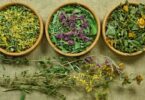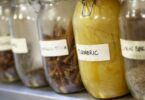Lavender (Lavandula) has been prized for its aesthetic, medicinal and aromatic values. Ancient people have used them as bath implements and had their blooms scattered inside their homes to ward off disease.
Today, the scent of lavender is still being used in aromatherapy to soothe headaches and to induce sleep. It is also used to ease the pain from burns and insect bites, reduce scarring and as a natural stomach relaxant.
There’s a multitude of ways to handle lavender and here are some tips to start planting, properly harvesting, drying and storing your own.
READ ALSO: 6 Food Drying Methods – Pros, Cons and Best Tips
Planting and harvesting your lavender
There is a selection of lavender varieties for different desired effects. If you’re looking for an energy boost, it is suggested to stick with Spanish lavender (Lavandula stoechas). It smells like eucalyptus and has an energizing effect. If you’re looking for calm and relaxation, the most popular English lavender (Lavandula angustifolia) is the best choice.
Once you’ve planted your lavender, the next step is to harvest the pieces when some of its buds are blooming. The best time to harvest lavender is in the late morning. This is when the plant is dry, the sun is less intense and the fragrance is the strongest.
You can opt to cut directly below the blooms to get the blossoms for drying, or cut a little bit lower to include a bit of stem into your cluster. Sharpened pruning shears or scissors are needed to ensure that plants are cut properly.
SEE ALSO: How to Grow Lavender Indoors
SEE ALSO: An Expert Guide to Harvesting Lavender
Cut pieces with stalks on them are best for decorative arrangements while blossoms are used to make potpourri, tea or baking ingredients.
How to Dry Lavender at Home
There are multiple ways of drying lavender. Most lavender drying enthusiasts suggest sticking to the manual drying methods to ensure that the quality of blossoms and plant essential oils are maintained.
Counter drying lavender
Lavender dries fairly quickly, simply harvest a few stalks. The simplest method is to simply lay the cut stalks flat on a dry countertop or table.
You can also spread it out on some old newspaper or a drying rack. You should ensure to keep your stalks are laid flat in the process. The lavender flowers will feel brittle once they’re done the drying.
Dry bunching
Cut a bunch of lavender stalks making sure that you leave a few inches of stem on the cut stalk. Group about 15 – 20 stalks together and tie them with an elastic band. This band will make sure that the stalks stick together while drying. You can always decorate it with colorful ribbon bands if you want it to be prettier to look at.
Once set, hang each bundle in a dark, warm, and dry place, like your basement or cellar. Make sure to hang it upside down to help retain its blossom shape. Keeping it in a dark and dry place will help the lavender keep its scent and color from fading fast. It is still important though to leave enough space to allow air to travel between the stalks.
Humid surroundings will cause mold to grow on the lavender stalks, rendering them useless. You can hang it from a wall peg, metal hook or a wire clothes hanger.
Drying lavender in the dehydrator
Here are the steps you need to take for drying lavender in the food dehydrator.
- Snip stems with lavender blossoms that are completely open. Clip off discolored or shrunken leaves and check for insects that might be hiding inside blossoms or leaves.
- Do not wash the lavender. Just place the cut stalks in a single layer on the dehydrator trays.
- Set your dehydrators on herbal setting and let is work for about 2 hours.
- After 2 hours, assess the stalks. If the blossoms, stems, and leaves are brittle and paper, it is done. If it still feels moist, leave it for another hour to dry.
- Once done, remove it from the dehydrator tray and let it cool completely. Once done, you can place the dried stalks in a container and seal the lead tightly.
NB! Food dehydrator can cause your stalks to over dehydrate if not monitored correctly.
READ ALSO: Which Food Dehydrator is Right for You
Drying lavender in the oven
Here are steps you need to take to for drying lavender in the oven:
- Set the oven to low heat at around 200 degrees Fahrenheit or 100 degrees Celsius. Spread a thin layer of lavender on a sheet tray and place it in the oven for about 10 minutes or until the stalks are completely brittle. Keep the oven door slightly open while drying. This will allow for moisture to pass through effectively. If it still feels moist after 10 minutes, rotate the stalks and then leave it for 5 more minutes to dry.
- Once done, remove the dried lavender from the oven and run your hand down the dried stalks until the blossoms fall into a container. You need to be careful as the blooms can be a bit prickly.
NB!! Processing requires keen supervision.
Drying lavender in the microwave
Similar to oven drying lavender, you need to first de-stem the blossoms. Separate the leaves and blossoms from the stem. Place a small amount of lavender across 2 layers of paper towels, a clean kitchen towel or just the turning tray and lay it in the microwave.
Turn on the microwave and let it run on high for about a minute. Check for dryness. If they still feel moist, continue drying with 20-second bursts until completely dry.
NB! High risk of over drying/ scorching the stalks if not monitored properly.
Storing Dried Lavender Properly
There are various ways to store your lavender. But it is critical to note that they should be stored away from light, heat, and humidity. Exposure to any of these elements risk for the plant color to fade, make it dry faster and make the fragrance fade. Moisture will invite mold to grow and destroy it.
READ ALSO: How to Store Dried Lavender
Lavender bundles can be kept suspended in coat hangers inside closets. It will fragrance your garments while stored.
Dried buds can be kept in zip lock bags or clean and airtight mason jars. Then store in a cool dark place until you’re ready to use.
READ ALSO: A Complete Guide on How to Store Dried Herbs





